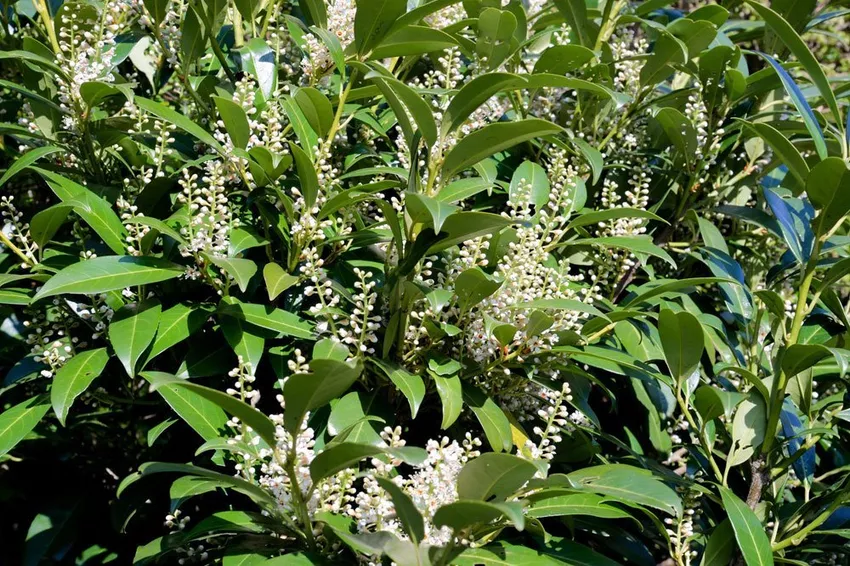If you want to plant cherry laurel, you have the choice between solitary or hedge planting. Read here what needs to be considered when caring for the laurel cherry.

The cherry laurel (Prunus laurocerasus) is an evergreen tree or shrub that is popularly known as the laurel cherry. It bears medium to dark green, smooth and glossy leaves that look deceptively like those of the true laurel. However, the two plants with similar-sounding names are not related.
- Family: Rosaceae
- Subfamily: Spiraeoideae
- Genus: Prunus
- Type: Laurel Cherry
- Botanical name: Prunus laurocerasus
From April to June, upright, raceme-like inflorescences appear on the ornamental tree, bringing pleasantly fragrant, white flowers to light. Later, small stone fruits form, which turn black until ripe. No matter how tempting the berries look, all parts of the plant are poisonous! The berries must therefore not be eaten.
| Cherry laurel (Prunus laurocerasus) | |
|---|---|
| Growth Speed: | 15 - 40 cm a year |
| Growth: | 200 - 350 cm |
| Growth: | 80 - 120 cm |
| Root system: | Herzwurzler |
| Location: | Sun to partial shade |
| Floor: | normal garden soil |
Growth and growth behavior of the cherry laurel
Extra tip:
The cherry laurel can easily be transplanted at any time.
The cherry laurel grows up to seven meters high and two to three meters wide. It grows medium to strong. Depending on the variety, growth of up to 40 centimeters per year is possible. The plant is suitable for both solitary and hedge planting. But it also thrives very well in tubs.
Important:
Laurel cherries are so-called neophytes. These are plants of foreign origin, some of which multiply unhindered and massively here. In the wild, the wood can even displace other native plants. In some areas, the laurel cherry is therefore already on theblack list. In the garden, however, you can keep the cherry laurel well under control.
Location and soil conditions
The cherry laurel prefers a sheltered spot. It tolerates sun and partial shade equally well. Normal garden soil is also ideal because the plant does not make any special demands on the soil.
Cherry laurel care

Pour cherry laurel
The laurel cherry suffers from drought. You should therefore water them regularly if it has not rained for a long time. Young plants also need a lot of water after planting.
Fertilize cherry laurel
In a nutrient-rich soil, fertilizer is not absolutely necessary. However, you can accelerate growth by fertilizing in the spring. Compost and manure are well suited, possibly mixed with horn shavings. Blue grain also causes stronger growth. You have to work this fertilizer into the soil. It is more convenient to use mineral fertilizers in liquid form. You can find more information on this in our article How to fertilize cherry laurel.
Cut cherry laurel
Shape and thinning cuts are important so that the cherry laurel does not overgrow too much. The laurel cherry is insensitive to pruning. Except in winter, you can therefore make a pruning at any time. You can cut off woody branches down to the ground. The wood will then sprout fresh again.
Cherry laurel overwinter
Most cherry laurel varieties are largely hardy. In the bucket, however, the cherry laurel needs frost protection. Overwintering in a cool, dry room is also beneficial.
For outdoor plants, some leaves may freeze in winter. But don't worry: the ornamental tree will recover quickly in spring and sprout again.
Diseases & Pests
The cherry laurel is relatively robust and mostly resistant to pests. Only the chlorosis (a lack of iron or other nutrients) can cause problems for the cherry laurel. You can recognize this by the yellow to brown leaves. Soil improvement is important in this case. You should then no longer use hard water for watering.